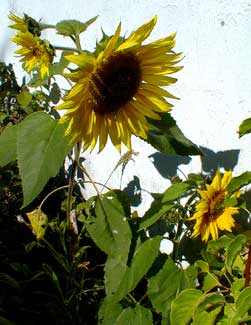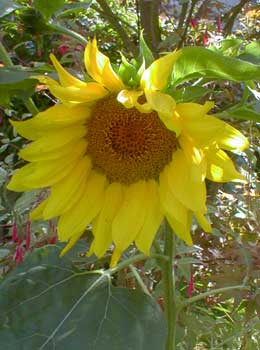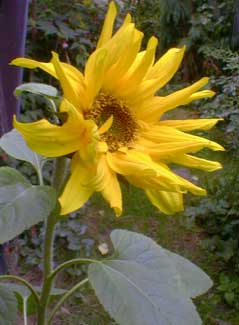
Black-seed Sunflower
"But on the hill the golden-rod,
and the aster in the wood,
And the yellow sunflower by the brook,
in autumn beauty stood."
-William Cullen Bryant
(1794-1878)
(1794-1878)
We don't actually plant sunflowers, but every year a few appear in the garden mostly immediately under hanging birdfeeders in full sun, though birds also drop the seeds elsewhere in the gardens. The birdfeeders contain primarily Black-oil sunflower seeds (Helianthus annuu), but some mixes include striped seeds.
 We take no special care of the sunflowers yet they do just fine. If a greater, maximum size & good seed production were desired, they would require occasional boosts of fertilizer to help them reach their fullest potential. I find them adequate as they are, & already so big they'd be intrusive if encouraged to grow over six feet.
We take no special care of the sunflowers yet they do just fine. If a greater, maximum size & good seed production were desired, they would require occasional boosts of fertilizer to help them reach their fullest potential. I find them adequate as they are, & already so big they'd be intrusive if encouraged to grow over six feet.We harvest the seeds for our pet ratties, as also sprays of millet that erupt under the birdfeeders. Often they get started late in the year, however, & the seeds don't fully ripen if autumn chills stop them in their tracks.
There are varieties bred for rapid development in two months, but many require summers longer than ours. Anyone really after the crops would probably want to start them indoors early in the year; they transplant into the garden with complete success.
 Because of the high calories of sunflower seeds, & especially of the black-seed oily type, the percentage included in mammal or bird diet has to be somewhat restricted.
Because of the high calories of sunflower seeds, & especially of the black-seed oily type, the percentage included in mammal or bird diet has to be somewhat restricted.Yet recent studies on bird nutrition have established that sunflower seeds are not the "junk food" candy-treats often imagined. For songbirds, the striped sunflower seed turns out to be a nearly ideal food, & the fattier black-oil sunflower seeds have softer-shelled so are appealing even to smallest birds.
 The seeds are rich in potassium, essential fatty acids, phosphorus, Vitamins E, Thiamin, Niacin, Riboflavine, manganese, zinc, an excellent source of calcium, with more iron than any other plant food, & are 25% protein.
The seeds are rich in potassium, essential fatty acids, phosphorus, Vitamins E, Thiamin, Niacin, Riboflavine, manganese, zinc, an excellent source of calcium, with more iron than any other plant food, & are 25% protein.There are around fifty species of sunflowers. The most commonly cultivated ones were originally native to the American Southwest & western plains & along the Missouri & Mississippi rivers. They are one of the most important of the North American native crop species, exceeded only by corn, with the black-seed sunflower today the second most important source of edible oil world-wide.
Archeologists have shown that they have been cultivated for five millenia, with the earliest known breeders of select cultivars having been Ozark Bluff Dwellers. As a food source it was transported by ancient tribal peoples throughout the Americas as far south as Peru & Argentina, becoming sacred to the Aztecs.
The first to sunflower photos are from September of different years, & the last photo from October. I've included an extra photo for the heck of it, of a chickadee up in the akebia vine above the very birdfeeder the sunflower seeds fall out of. The bird photo was snapped in our garden by Vicki Marsh during a summer visit.